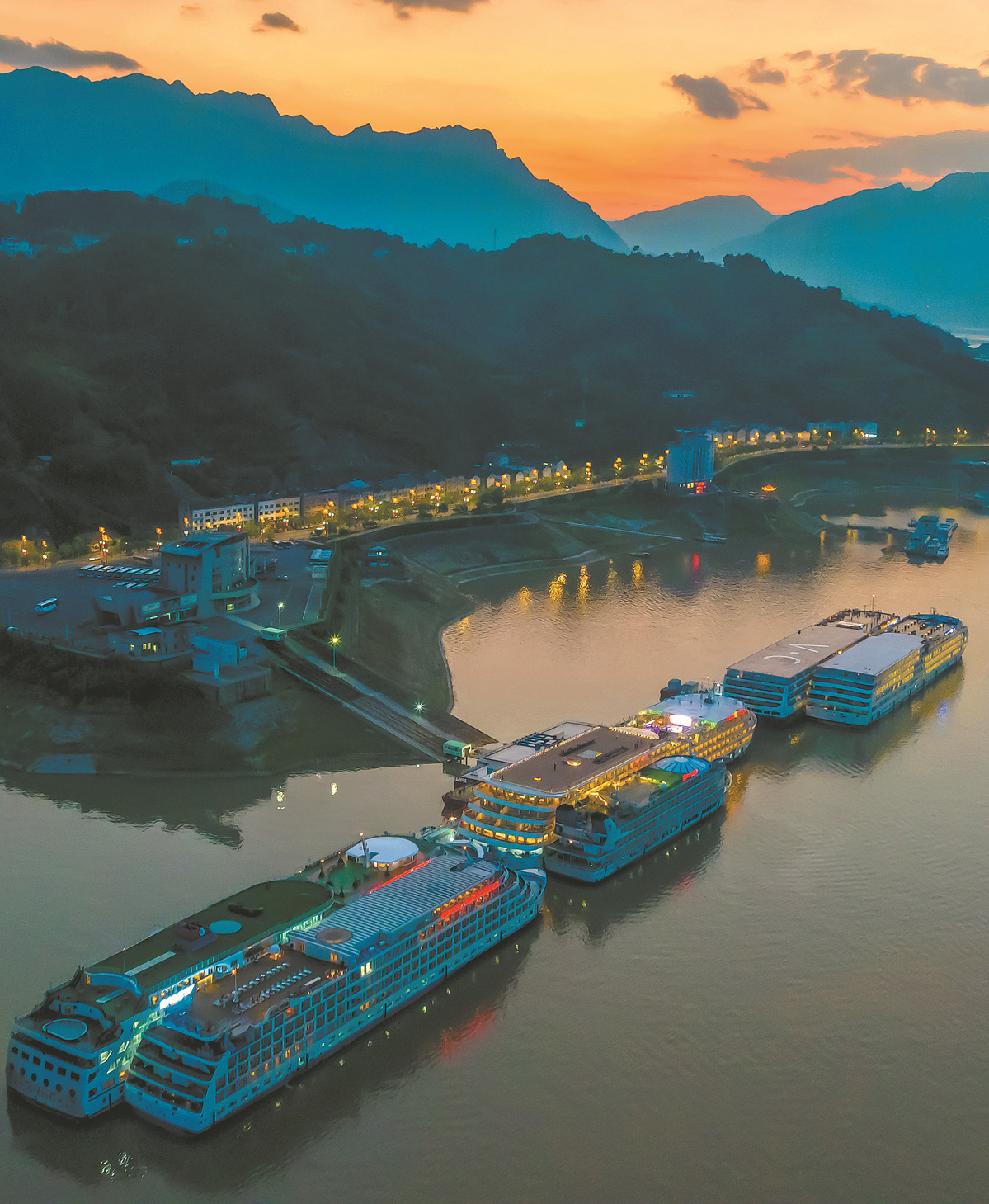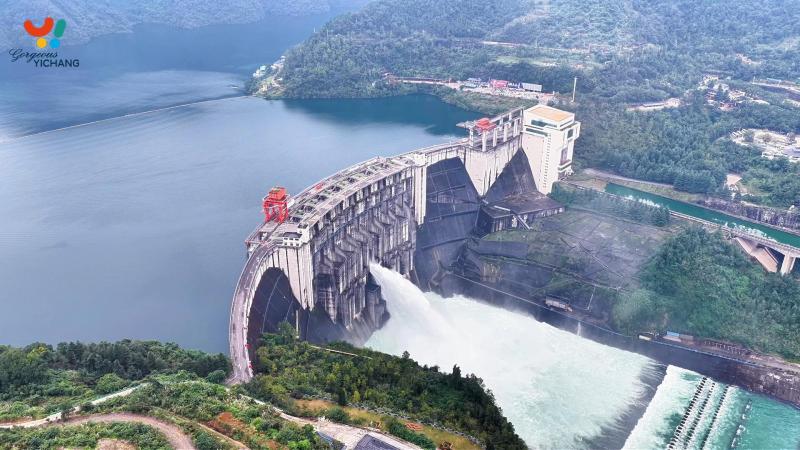Shore power fueling more vessels at port
2024-04-28 20:04:11
By Hou Liqiang in Beijing, Liu Kun in Wuhan,Liu Kun and Tan Yingzi in Chongqing | China Daily
 Cruise ships use a shore power dock at a port on the Yangtze River in Zigui, Hubei province, in August. ZHENG JIAYU/FOR CHINA DAILY
Cruise ships use a shore power dock at a port on the Yangtze River in Zigui, Hubei province, in August. ZHENG JIAYU/FOR CHINA DAILY
A greater number of vessels operating in the Yangtze River Economic Belt are using shore power, signifying progress is being made on the low-carbon development of the belt across its nine regions.
According to the Changjiang River Administration of Navigational Affairs and the Ministry of Transport, ships at berth consumed 120 million kilowatt-hours of shore power last year, up 64 percent from 2022.
This means the belt has surpassed its target of reaching 100 million kWh two years ahead of schedule, the administration said.
It said the number of ships fueled by new and clean energies in watercourses in the Yangtze River Basin had reached more than 300 as of the end of last year.
Shore power allows ships to connect to the local electricity grid while at port, instead of turning to diesel engines to generate electricity. This can significantly reduce emissions from vessels, contributing to cleaner air and the reduction of carbon dioxide emissions.
The Yangtze River Economic Belt covers nine of the 11 regions in the Yangtze's main flow. The flow through Qinghai province and the Xizang autonomous region are the exceptions. It also includes Zhejiang and Guizhou provinces, which are home to several important tributaries of the Yangtze.
Li Guoyun, captain of the cruise ship Century Glory, said the consumption of shore power is not only environmentally friendly but also costs less.
"Generating electricity with oil creates a loud noise and results in poor passenger experience. The cost from that is high, too," he said while his ship berthed at Chaotianmen Port in Chongqing. The vessel was connected to shore power via a floating transformer substation.
The use of shore power helps reduce electricity costs at berth by half, he added.
China saw the first batch of shore power facilities installed in 2015 in Hubei province's Yichang city, home to the Three Gorges Dam, the world's largest hydropower project.
As a senior executive with the shore power service provider in Yichang, Wan Zhiyong said there has been a significant increase in their business.
When the first batch of shore power facilities was put into operation at the Shawan anchorage ground in April 2015, only 10,000 kWh of shore power was consumed that year, which was only 1 percent of the supply capability.
Now, the daily power consumption in Yichang's Zigui Port alone reaches more than 6,000 kWh, he said. Last year, the total shore power consumption in Yichang surpassed 1.2 million kWh, which avoided the consumption of 2,857 metric tons of oil for power generation and reduced emissions of harmful substances by 8,998 tons, according to Wan.
"Previously, we had to beg ships to use shore power, but now they are eager to use it," he said.
 Cruise ships use a shore power dock at a port on the Yangtze River in Zigui, Hubei province, in August. ZHENG JIAYU/FOR CHINA DAILY
Cruise ships use a shore power dock at a port on the Yangtze River in Zigui, Hubei province, in August. ZHENG JIAYU/FOR CHINA DAILYA greater number of vessels operating in the Yangtze River Economic Belt are using shore power, signifying progress is being made on the low-carbon development of the belt across its nine regions.
According to the Changjiang River Administration of Navigational Affairs and the Ministry of Transport, ships at berth consumed 120 million kilowatt-hours of shore power last year, up 64 percent from 2022.
This means the belt has surpassed its target of reaching 100 million kWh two years ahead of schedule, the administration said.
It said the number of ships fueled by new and clean energies in watercourses in the Yangtze River Basin had reached more than 300 as of the end of last year.
Shore power allows ships to connect to the local electricity grid while at port, instead of turning to diesel engines to generate electricity. This can significantly reduce emissions from vessels, contributing to cleaner air and the reduction of carbon dioxide emissions.
The Yangtze River Economic Belt covers nine of the 11 regions in the Yangtze's main flow. The flow through Qinghai province and the Xizang autonomous region are the exceptions. It also includes Zhejiang and Guizhou provinces, which are home to several important tributaries of the Yangtze.
Li Guoyun, captain of the cruise ship Century Glory, said the consumption of shore power is not only environmentally friendly but also costs less.
"Generating electricity with oil creates a loud noise and results in poor passenger experience. The cost from that is high, too," he said while his ship berthed at Chaotianmen Port in Chongqing. The vessel was connected to shore power via a floating transformer substation.
The use of shore power helps reduce electricity costs at berth by half, he added.
China saw the first batch of shore power facilities installed in 2015 in Hubei province's Yichang city, home to the Three Gorges Dam, the world's largest hydropower project.
As a senior executive with the shore power service provider in Yichang, Wan Zhiyong said there has been a significant increase in their business.
When the first batch of shore power facilities was put into operation at the Shawan anchorage ground in April 2015, only 10,000 kWh of shore power was consumed that year, which was only 1 percent of the supply capability.
Now, the daily power consumption in Yichang's Zigui Port alone reaches more than 6,000 kWh, he said. Last year, the total shore power consumption in Yichang surpassed 1.2 million kWh, which avoided the consumption of 2,857 metric tons of oil for power generation and reduced emissions of harmful substances by 8,998 tons, according to Wan.
"Previously, we had to beg ships to use shore power, but now they are eager to use it," he said.






